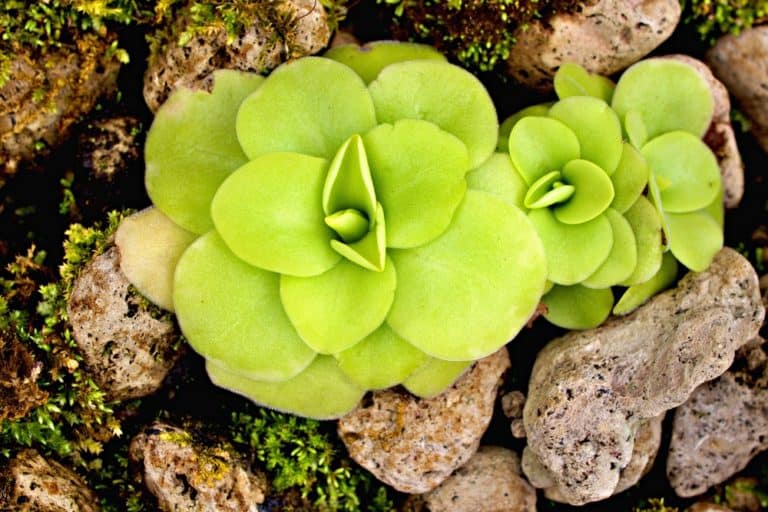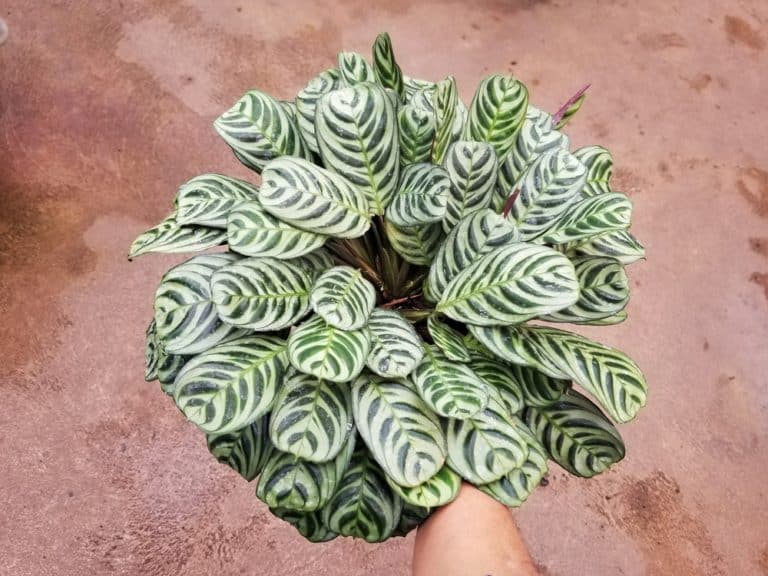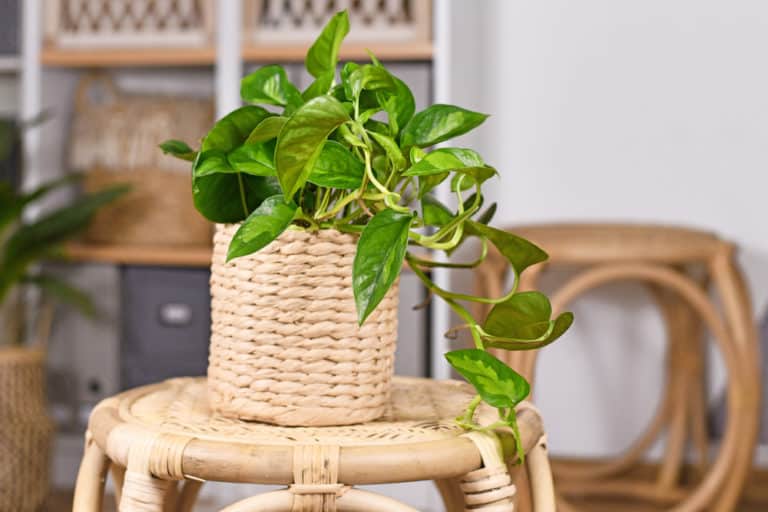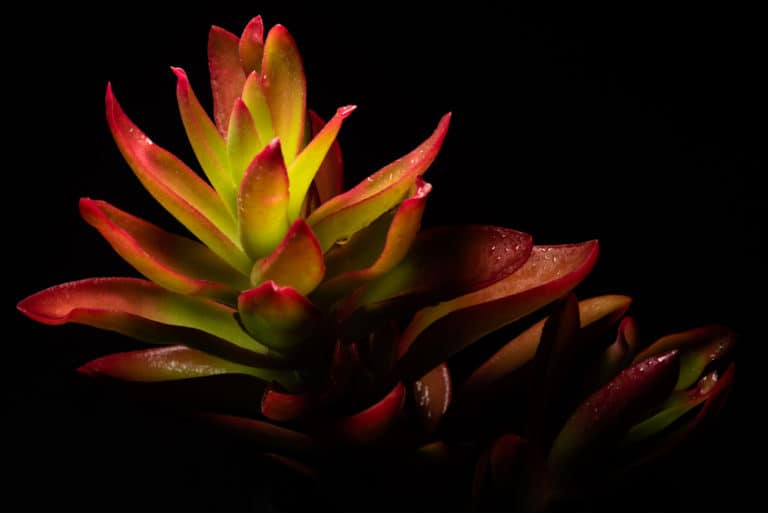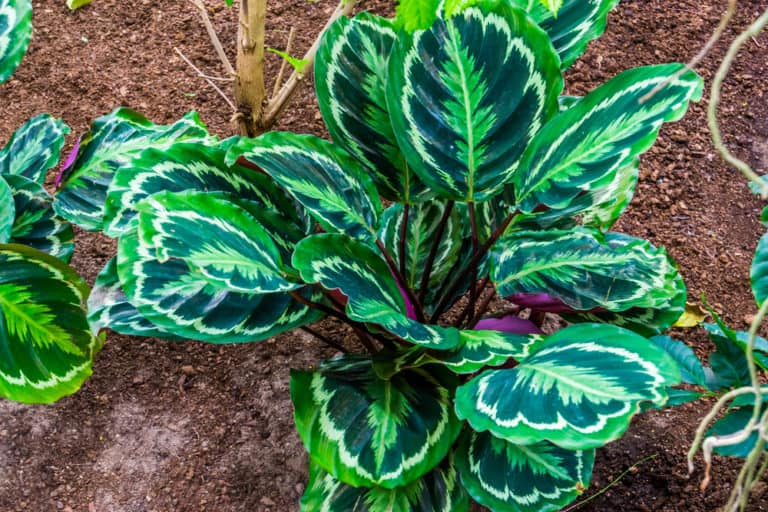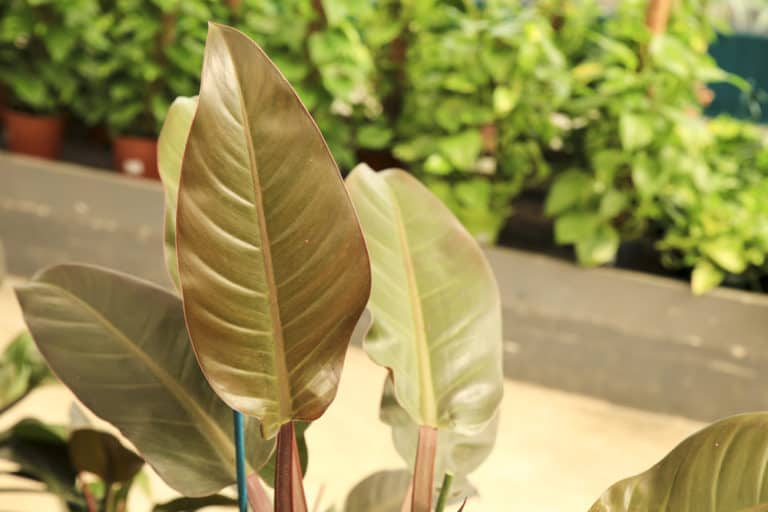Pilea Nummulariifolia ‘Creeping Charlie’ Care Guide (2024)

The Creeping Charlie houseplant is often grown in a hanging basket or in a terrarium, where its bright green foliage will remain fresh all year.
Its scientific name is Pilea nummulariifolia, and should not be confused with Glechoma hederacea, another ground cover also called Creeping Charlie.
While Glechoma hederacea will survive cold winters outdoors, Pilea nummulariifolia is a tropical plant.
| Scientific Name | Pilea nummulariifolia |
| Common Name | Creeping Charlie, Creeping Pilea, Swedish Ivy |
| Light | Bright indirect sunlight |
| Watering | Water if the top inch of soil is dry |
| Temperature | 65 to 80ºF (18 to 27ºC) |
| Hardiness Zone | 10, 11, 12 |
| Humidity | 40-60% |
| Soil Type | Rich, quick-draining, loamy |
| Soil pH | 6-7.5 (acid to neutral) |
| Fertilizing | A balanced feed once a month in spring and summer |
| Repotting | Every 2-3 years |
| Pruning | Beginning of the growing season |
| Propagation | Stem cuttings or root division |
| Toxicity | Not toxic to humans and pets |
| Mature Size | 4 to 8 inches as a houseplant |
| Bloom Time | Year-round |
What’s Unique About Creeping Charlie?
The Creeping Charlie plant is native to the West Indies and the top end of South America, where it grows in tropical rainforests as a spreading ground cover.
When grown outdoors, Creeping Charlie plants can become invasive. However, when they are confined to pots and grown indoors, they are a fast-growing houseplant that will quickly give your home a fresh green accent.
Growing Creeping Charlie is easy, even for beginners. It is an undemanding plant once you have provided it with a few key essentials for healthy growth.
A bonus for pet parents is that Creeping Charlie is perfectly safe for animals (and humans, for that matter).
Creeping Charlie Care
Creeping Charlie originates in the West Indies, where it thrives in the tropical rainforests.
Knowing its native environment will help you supply the perfect Creeping Charlie plant care.
Good Charlie houseplant care includes keeping the plant out of the direct sun, keeping the soil consistently moist, and never exposing it to cool temperatures.
Light
In the rainforests where it was discovered, Creeping Charlie grows under the protection of the tree canopy. While some of the bright tropical sun still gets through to the ground, it is filtered by the time it gets to Creeping Charlie.
Creeping Charlie light requirements are for filtered light or semi-shade, or between 2,500 to 10,000 lux.
Most homes can easily meet those Creeping Charlie plant light needs without using any supplemental lights.
In a north or east window, Creeping Charlie will get sufficient daily light without exposure to the punishing rays of the afternoon full sun.
If you need to keep your Creeping Charlie in a south or west room, keep it several feet away from the windows.
Watering
In the tropical rainforest, Creeping Charlie is used to consistently moist but well-drained soil, so your Creeping Charlie watering should try to replicate that as closely as possible.
Water Charlie houseplant when the top inch of the soil has dried out. Its watering needs may be as often as several times a week.
Use a watering can with a narrow spout so that you can direct the water right onto the soil without getting the leaves wet. Water slowly to allow the soil to get fully moistened, and let any excess drain out before placing the pot back in its saucer.
Temperature
The ideal temperature for Creeping Charlie plant is from 65 to 80ºF (18 to 27ºC), as it is used to consistently warm temperatures in the tropical rainforests.
You should have no trouble maintaining the low end of the Creeping Charlie temperature range in the average heated home in winter. Don’t worry if the higher temperatures aren’t obtainable.
If you want to give your Creeping Charlie a treat in summer, take it out to a shady spot on your patio when it gets hot and steamy.
Be careful, though; Creeping Charlie has limited temperature tolerance below 50°F (10°C). If nighttime lows fall much below that, it’s time to bring your tender tropical back in.
Finally, Creeping Charlie has no frost hardiness whatsoever.
Humidity
The ideal humidity for Creeping Charlie is around 50%, although it will do fine in the range of 40-60%.
If you can’t satisfy your Creeping Charlie humidity requirements with supplementing your home’s humidity level, you have a few good options.
The easiest but most time-consuming method is to give your Creeping Charlie a daily misting. Use a very fine spray and distilled or rain water.
You can also place your Creeping Charlie on a pebble-lined tray filled with water. The water will evaporate and add moisture to the air, while the pebbles keep the pot above the water level.
Finally, you can buy a small humidifier. This is the best option if you have several tropical plants that you can group together.
Soil
While Creeping Charlie needs consistently moist soil, it will not survive if the soil mix is saturated with water.
Creeping Charlie soil needs to hold a moderate amount of moisture, while at the same time easily draining any excess so the roots can breathe.
The best pH level for Creeping Charlie is 6-7.5, or mildly acidic to neutral.
If you want to buy a ready-mixed soil for Creeping Charlie houseplant, look for an African Violet mix which has all the qualities you need.
Otherwise, use a standard peat-based mix to which you’ve added a scoop each of perlite and well-rotted compost.
Fertilizer
You should use fertilizer for Creeping Charlie plant throughout its growing season to keep its lovely leaves growing lush and healthy.
If you added compost or slow-release fertilizer granules when you repotted, you don’t need to do anything to maintain soil fertility until the next time you repot.
Otherwise, look for a balanced fertilizer ratio of 10-10-10, or 3-1-2 if you really want to give its foliage a boost.
Liquid houseplant fertilizer is the most convenient to use. Dilute it to half strength and apply your Creeping Charlie fertilizer right after you’ve watered the soil to ensure that it gets absorbed by the soil.
Potting & Repotting
This tropical ground cover is a fast-growing perennial, so you can expect to have to do Creeping Charlie repotting 2-3 years.
Rather than stick to a schedule, however, keep an eye on the growth of your Creeping Charlie to see when it is necessary.
When you see roots coming out of the drainage holes, or find that the roots have completely engulfed the soil, it’s time for repotting Creeping Charlie houseplant.
It prefers slightly cramped conditions, so only go up one pot size, or at most 2 inches. The pot must have good drainage holes.
Use fresh potting soil whenever you repot your Creeping Charlie.
Pruning
Because it is such a fast-growing plant, you will find yourself doing some Creeping Charlie pruning to maintain an attractive shape.
Of course, whenever you see a dead or damaged leaf, cut it out immediately, cutting the leaf stem back close to where it joins the main stem.
You can also trim out any stems that are going off in directions you don’t want, or pinch off the growing tips to encourage bushier lateral growth.
Cutting Creeping Charlie can be done with just your thumbnail, as the stems are small and soft.
If you do use scissors, make sure that they are sharp and sterilized.
Propagation
It’s easy to propagate Creeping Charlie houseplant by stem cuttings or root division.
For Creeping Charlie propagation with stem cuttings, take healthy stems with several leaves and cut them with sharp, sterilized scissors.
Leave a couple of leaves at the tip, and set the stems in a tray with moistened peat moss, or in a jar of water.
Cover them with a plastic bag to maintain a humid atmosphere, and keep them warm but out of strong light.
Within a month you should have rooted cuttings.
For root division, when you are repotting your Creeping Charlie, cut or pull the roots apart to create a few separate clumps, and pot each one up.
Common Problems of Creeping Charlie
There are very few potential Creeping Charlie problems, but no houseplant is immune to all pests and diseases.
Luckily, you can prevent most problems with Creeping Charlie by paying close attention to its preferred growing conditions.
Keeping a close eye on Creeping Charlie’s leaves can help you detect problems before they get out of control.
Pests
There are not a lot of Creeping Charlie pests, but some bugs love to feed on the sap in the succulent leaves of Creeping Charlie.
Spider mites leave little white or yellow spots across the tops of the leaves.
Whiteflies are small, soft-bodied flying insects that congregate under the leaves.
For both of these bugs, wash down all surfaces of the plant with a hand-held shower or sink nozzle to get rid of them.
Mealybugs and their eggs can be found on the underside of leaves, resembling little puffs of cotton. Wipe them off with rubbing alcohol.
To prevent more insects from turning up, spray once a month or so with insecticidal soap.
Diseases
If you overwater your plant, you are increasing the chance that Creeping Charlie diseases will get established. The Creeping Charlie plant can fall victim to fungal or bacterial diseases from too-wet soil.
Xanthomonas Campestris, or bacterial leaf spot, looks like small, saturated spots on the leaves. Cut off all affected leaves and use a copper fungicide to prevent the disease from returning.
Root rot is a fungal disease when the soil is so saturated that no air can get to the roots. Leaves start to turn yellow, and the stems get mushy.
Pull the root ball out of its pot and cut away any black roots, as well as all affected foliage. Then repot in fresh, well-draining soil and cut back on your watering frequency.
Growing Problems
Most Creeping Charlie growing problems are a result of inadequate growing conditions, resulting in a sick plant.
If the leaves of your Creeping Charlie are turning brown or black, it’s getting too much direct light. Move it to a shadier spot in the room, or screen it from the full sun with a curtain to filter the light.
If the leaves are falling off, it’s likely that your Creeping Charlie is in too drafty a spot, and needs a warmer location. Move it so that it is not in the direct blast of an air conditioner vent, or a cool breeze from an open window.
Toxicity of Creeping Charlie
Creeping Charlie houseplant is not toxic to humans and pets.
Its lack of toxicity makes it the perfect houseplant to use in a home with children, cats, dogs, and rabbits, all of which may try nibbling on foliage from time to time.
However, it’s best to discourage anyone from eating your houseplants just as a general rule.
For Humans
Creeping Charlie is not toxic at all to humans. No parts of the plant contain any toxic substances or even mild skin irritants.
Some people actually say that it is edible and can be used in teas.
However, especially if you’re using insecticidal sprays on your Creeping Charlie, it’s probably best to not experiment, and instead, just enjoy looking at its lovely foliage.
For that same reason, you should keep your Creeping Charlie out of reach of children.
Luckily, it’s easy to accomplish that, as Creeping Charlie is a trailing plant that is well-suited to hanging baskets or pots on a high shelf.
For Pets
Creeping Charlie is not at all toxic to pets, including cats, dogs, and rabbits.
Given the toxicity of so many tropical plants, that’s a welcome relief for pet owners who also want indoor gardens.
However, you still don’t want your pets eating your Creeping Charlie.
Cats and dogs are carnivores, and their digestive systems cannot handle a lot of vegetative material. If your pet eats too many leaves, it can end up with vomiting and diarrhea.
It won’t require a trip to the vet, but it’s going to be unpleasant for all concerned.
As well, cats can do a fair bit of damage to a houseplant. It’s a good idea to keep your Creeping Charlie out of their reach.
Creeping Charlie Appearance
You will never be disappointed by the Creeping Charlie appearance.
Its attractive evergreen leaves will add a fresh, tropical touch to any space year-round, and you’ve got lots of options on how to display it.
As well, its fast growth rate means you don’t even have to wait long to see it in all its beauty.
Foliage
The foliage of Creeping Charlie is its main attraction as a houseplant.
Each leaf is a fresh, bright green, with a crinkly texture and glossy surface. The veins are sunken, giving the foliage a 3-dimensional appearance.
The rounded leaves are about 1.5 to 2 inches long. They have a scalloped edge.
Leaves will gradually yellow and die, starting with the older ones at the bottom of the plant. New leaves are formed at the growing tip.
The petioles are short, with fine hairs. They can be yellow-green or reddish. Each petiole supports one leaf growing at its tip.
The main stalks are erect and have multiple petioles.
Flowering
Creeping Charlie flowering can occur at any time. A Creeping Charlie flower can be pale green, white, or lavender.
The tiny flowers grow in a cluster with a whorled pattern, growing around the base of the newest leaves at the growing tip.
However, the flowers of Creeping Charlie do not stand out much when they are blooming. As well, they rarely set fruit when grown indoors, and if they do, the small brown berries are unremarkable.
Instead, grow your Creeping Charlie for its bright, fresh-looking foliage and trailing habit. That’s the reason this tropical plant is such a popular houseplant.
Size and Growth
You can expect the mature size of Creeping Charlie to be about 4 to 8 inches high, with a spread of 1 to 2 feet.
Creeping Charlie has a rapid growth rate, reaching its full size within a couple of years.
It’s also got a limited lifespan, and may only last 3 or 4 years.
However, if you have propagated new plants from stem cuttings or root division, you should be able to always have a young and vigorous Creeping Charlie or two in your indoor garden.
Outdoors, Creeping Charlie is considered an invasive plant that will quickly spread and choke out other plants.
Creeping Charlie Fragrance
There is no Creeping Charlie fragrance.
The foliage has no scent, and there is little or no fragrance from its flowers.
For people with a strong sensitivity to fragrances, Creeping Charlie is a perfect plant to use indoors. Even in a small studio apartment, you will not have to worry about your limited space being overwhelmed by a strong scent.
Similarly, many public spaces, especially hospitals and nursing homes, prefer to use scentless plants, and so Creeping Charlie is a popular choice for settings like this.
Its fragrance-free nature, combined with its ease of maintenance, makes using Creeping Charlie an easy way to add fuss-free greenery almost anywhere.
Suggested Uses for Creeping Charlie
Finding a spot indoors for a Creeping Charlie plant is not difficult.
Its small size and trailing habit lend itself perfectly to growing in a hanging basket, where its long tendrils will spill down gracefully.
You could even use a series of planters in a row to create a living screen between 2 parts of a room. It’s a perfect way to define spaces in a small studio apartment.
Moving planters outdoors for the summer months can help you easily create a tropical garden.
However, even if you live in a tropical climate, you should think twice before planting Creeping Charlie in the ground. It spreads quickly and will soon become an invasive weed.
FAQ
What is Creeping Charlie?
Creeping Charlie is a perennial evergreen ground cover, native to the West Indies and northern South America. It is commonly grown as a potted plant.
How to identify Creeping Charlie?
Creeping Charlie is a trailing plant with bright green glossy leaves with deep veins and scalloped edges. It has small white, green or purple flowers borne in clusters.
How to care for Creeping Charlie?
Creeping Charlie should be planted in consistently moist but not wet soil and kept in semi-shade or filtered light. Fertilize once a month in spring and summer.
How to grow Creeping Charlie indoors?
Keep Creeping Charlie out of direct sun and water regularly to keep the soil consistently moist, in a warm and humid atmosphere. Prune to maintain healthy growth.
How to grow Creeping Charlie outdoors?
Creeping Charlie should only be grown outdoors in tropical climates in containers, as it can quickly spread and become an invasive weed outside its native rainforests.
How fast does Creeping Charlie grow?
Creeping Charlie grows quickly to its full size over a couple of years, but may only live another couple of years beyond that before it dies.
How tall does Creeping Charlie grow?
Creeping Charlie grows to 4 to 8 inches tall, with a spread of 1 to 2 feet. It has a creeping habit which is suited to trailing out of a hanging planter.
How to make Creeping Charlie grow faster?
Creeping Charlie will grow its fastest when given its ideal growing conditions of warmth, high humidity, dappled light and regular fertilizing of its moist soil.
How to stake Creeping Charlie?
Creeping Charlie should not be staked. It is a creeping plant, not a vining one. It is much better to be grown trailing out of a hanging planter or from a high shelf.
How to pot Creeping Charlie?
Creeping Charlie should be potted in a container with good drainage, in porous soil that will retain moisture but drain out excess water easily.
How to revive Creeping Charlie?
If your Creeping Charlie’s soil has dried out, set the whole pot into enough water to cover it, and hold it down until it cannot absorb any more water. Drain all excess water.
Why is my Creeping Charlie dying?
Your Creeping Charlie may have a bacterial or fungal disease, which is usually caused by overwatering. Cut out all affected tissues and repot in fresh soil.
Why is my Creeping Charlie drooping?
Your Creeping Charlie may be overwatered or drying out. Check the moisture level in the soil and either water it or replace the saturated soil.
How cold can Creeping Charlie tolerate?
Creeping Charlie will start dropping leaves when kept at temperatures below 50ºF (10ºC). It has no frost tolerance and freezing temperatures will kill it outright.
How to get rid of pests on Creeping Charlie?
If your Creeping Charlie has an infestation of insects, clean them off and use an insecticidal soap spray to prevent bugs from re-establishing themselves in the future.
Is Creeping Charlie toxic to cats?
No, Creeping Charlie is not toxic to cats. They may have vomiting and diarrhea if they eat too much foliage, but won’t need to see the vet.
Is Creeping Charlie toxic to dogs?
No, Creeping Charlie is not toxic to dogs. They still should not eat the foliage because their digestive systems cannot handle too much vegetative matter.
Is Creeping Charlie toxic to children?
No, Creeping Charlie is not toxic to children. However, any sprays used to control insects could have an adverse effect so plants should be kept out of reach.
Is Creeping Charlie toxic to humans?
No, Creeping Charlie is not toxic to humans. In addition, there is no evidence of anyone having an allergic reaction after exposure to this plant.
Does Creeping Charlie have a scent?
The foliage and flowers of Creeping Charlie have no discernable scent, making it a good plant to use around people with fragrance sensitivities or allergies.

